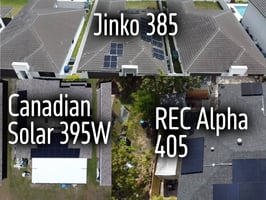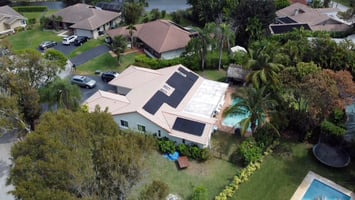In the sunny locales of Miami and Broward, Florida, solar panels are gaining momentum as a key...
Harnessing the Florida Sun: A Comprehensive Guide to Solar Panel Investment
Welcome to the Sunshine State, where solar energy isn't just a dream, it's a bright reality! In Florida, solar panels have become more than just a trend; they're a smart investment for homeowners looking to capitalize on the state's abundant natural resource: sunlight. But before you jump on the solar bandwagon, it's crucial to understand the financial landscape. Solar panels can cost anywhere between $4,500 and $36,000, a wide range that often leaves potential buyers wondering about the best option for their homes and wallets. This guide is your beacon, shining light on everything from costs to types of solar panels, making your journey towards solar investment as clear as a sunny Florida day.
The Financial Sunscape: Understanding Solar Panel Costs
When it comes to solar panels, one size doesn't fit all, especially in terms of cost. The average price tag of around $16,000 can sway significantly based on several key factors:
Types and Models of Panels
The type of solar panel you choose plays a significant role in the overall cost. Do you opt for the more efficient but pricey monocrystalline panels, or the more affordable polycrystalline panels? Each type comes with its own set of pros and cons, not just in efficiency and price, but also in durability and suitability for your specific home environment.
Inverters and Balance of System (BOS)
Beyond the panels themselves, the cost of inverters and the balance of the system equipment, which includes all necessary components to get your solar system up and running, also factors into the total price. These can include mounting systems, wiring, and other electrical components. The quality, brand, and capacity of these components can significantly impact the overall cost.
Solar Panel Installation
Labor costs for installation can vary widely. In Florida, where solar panel installation is in high demand, prices may differ from less sunny states. The complexity of your home's roof and the ease of installation also play a role in determining these costs.
Types of Solar Panels: Options and Costs
In the world of solar panels, variety is key. Florida's homeowners have a range of options, each with its own price tag and efficiency level. Let's bask in the details of the most popular types:
Monocrystalline Solar Panels
These are the Ferraris of solar panels, known for their high efficiency and sleek, dark appearance. Monocrystalline panels are made from single-crystal silicon, making them more effective at converting sunlight into electricity. This efficiency comes at a cost, typically $1 to $1.50 per watt. For a standard 6kW system, you're looking at a range of $6,000 to $9,000. But with a lifespan of up to 40 years, they're an investment that can pay off in the long Florida sun-drenched run.
Polycrystalline Solar Panels
If monocrystalline panels are Ferraris, think of polycrystalline panels as the reliable Honda. They're made from multiple silicon crystals and are slightly less efficient. However, they compensate with a more budget-friendly price of about $0.75 to $1 per watt. For a 6kW system, this means a cost range between $4,500 and $6,000. Their average lifespan is about 25 to 30 years, offering a balance between efficiency, cost, and longevity.
Thin-Film Solar Panels
These are the new kids on the block, distinct for their thin and flexible design. They can cost between $0.75 and $1.10 per watt, making a 6kW system range from $4,500 to $6,600. Thin-film panels are less efficient than their crystalline counterparts and have a shorter lifespan of about 10 to 20 years. However, they are lightweight and versatile, making them suitable for certain types of roofs where traditional panels might not be the best fit.
Solar Panel Installation: Process and Costs
The journey from deciding to go solar to actually generating power involves several steps and costs.
The Installation Process
In Florida, the process begins with choosing the right panels and a reputable installer. Once you've got your gear, the installation involves setting up a mounting system, attaching the panels, and connecting them to your home's power system. This process can vary in complexity depending on your home's layout and the type of panels you've chosen.
Factors Influencing Installation Costs
- Amount of Sunlight: Florida's abundant sunshine can actually reduce the number of panels you need, impacting the overall cost.
- Local Incentives: Florida offers various incentives for solar panel installation, which can significantly lower your out-of-pocket costs.
- Roof Characteristics: The complexity of your roof – its pitch, material, and available space – can affect installation costs. A more complex roof might mean a higher price tag for installation.
Average Costs in Florida
While the national average for solar panel installation hovers around the figures mentioned earlier, Florida's rates might differ slightly due to its solar-friendly climate and state incentives. Generally, expect the installation costs to be a substantial part of your total solar investment.
Solar Savings: Calculating Your Return on Investment
Investing in solar panels is not just about reducing your carbon footprint; it's also a financial decision that can yield significant returns. For Florida homeowners, the sunny climate is a boon for solar power generation.
Estimating Yearly Energy Savings
The key to understanding your potential savings lies in your current energy consumption and the efficiency of your chosen solar system. In Florida, where the average household might consume around 1,141.50 kWh per month, solar panels can lead to considerable savings. By replacing grid electricity with solar power, you can save an estimated $1,910.87 annually, depending on your system's coverage and local electricity rates.
The Break-Even Point
The break-even point is when the savings from your solar panels equal the initial investment. In Florida, thanks to the state's generous sunlight and potential incentives, this point can be reached relatively quickly. On average, Florida homeowners might expect to break even on their solar panel investment in about 5.39 years, though this varies based on system size and initial costs.
Financing Your Solar Dream
Solar panels represent a significant upfront investment. Fortunately, there are several financing options available to make solar power more accessible.
Cash Purchase
Paying upfront in cash is the most straightforward method. It allows you to own the system outright and immediately benefit from tax credits and rebates. While this requires a substantial initial outlay, it eliminates ongoing finance costs and maximizes long-term savings.
Solar Loans
Solar loans can spread the cost of your system over several years, making solar panels more attainable if you can't pay cash upfront. These loans come in various forms, with different interest rates and terms, allowing for flexibility in financing your solar investment.
Solar Leases or Power Purchase Agreements (PPAs)
With a lease or PPA, you don't own the solar panels. Instead, a third party installs and maintains the system on your property, and you pay a monthly fee for the energy it produces. This option can offer lower upfront costs but might not provide the same long-term financial benefits as owning the system.
Additional Financing Options
- Cash-Out Refinance: If you’re refinancing your mortgage, you might consider a cash-out refinance to fund your solar installation.
- Home Equity Line of Credit (HELOC): This option allows you to borrow against your home's equity at a lower interest rate, providing another way to finance your solar system.
Additional Solar Panel Costs to Consider
While the benefits of solar energy are clear, it's important to be aware of the ongoing costs associated with solar panel ownership.
Maintenance Costs
Solar panels are relatively low-maintenance, but regular check-ups are crucial to ensure they function efficiently. In Florida, maintenance costs range between $280 to $720 annually, depending on the size of your system and the frequency of servicing.
Cleaning Services
The efficiency of solar panels can be affected by dirt and debris. Cleaning costs around $25 per panel, with an average solar system requiring $425 to $525 for a full clean. This service is generally recommended once or twice a year, depending on local conditions.
Home Insurance Implications
Installing solar panels can increase your home's value, which might lead to a slight increase in your homeowner's insurance premiums. It's important to update your policy to cover the replacement cost of your solar panels in case of damage.
Solar System Monitoring
Monitoring systems allow you to track your solar system’s performance. Prices for these systems can range from free to $400, depending on the complexity and features offered.
Tree Trimming
For optimal solar panel efficiency, you might need to trim surrounding trees. This can cost between $250 and $700, depending on the number of trees and the complexity of the job.
Roof Repair and Preparation
If your roof needs repairs or reinforcement before installation, costs can range from $150 for minor repairs to $7,000 for major ones. It's essential to ensure your roof is in good condition to support the solar panels.
Solar Panel Installation Process
Installing solar panels is a detailed process that requires careful planning and execution.
Compatibility Check
First, ensure your home is suitable for solar panels. This involves checking the condition of your roof, the compatibility of your electrical system, and ensuring there are no shading issues that could affect performance.
System Sizing
The size of your solar system will depend on your energy needs and roof space. In Florida, where sunlight is abundant, you may require fewer panels than in less sunny regions.
Permitting and Incentives
Before installation, you'll need to secure the necessary permits. Additionally, explore local and federal incentives that can reduce the overall cost of your system.
Installation
The actual installation involves mounting the solar panels, connecting them to an inverter, and integrating them into your home's electrical system. This process is typically completed within a few days, depending on the size and complexity of the system.
Are Solar Panels Worth It in Florida?
Finally, the big question: Are solar panels a good investment in Florida? The answer is a resounding yes for several reasons:
- Abundant Sunshine: Florida's sunny climate means more efficient energy production.
- Financial Incentives: State-specific incentives and federal tax credits can significantly reduce the cost.
- Energy Savings: Solar panels can substantially reduce or even eliminate your electricity bills.
- Environmental Impact: Solar energy is a clean, renewable resource that reduces carbon emissions.
Conclusion
In conclusion, while the upfront costs of solar panels can be significant, the long-term savings, environmental benefits, and increasing home value make them a wise investment for Florida homeowners. With abundant sunshine and favorable incentives, there's never been a better time to go solar in the Sunshine State.



